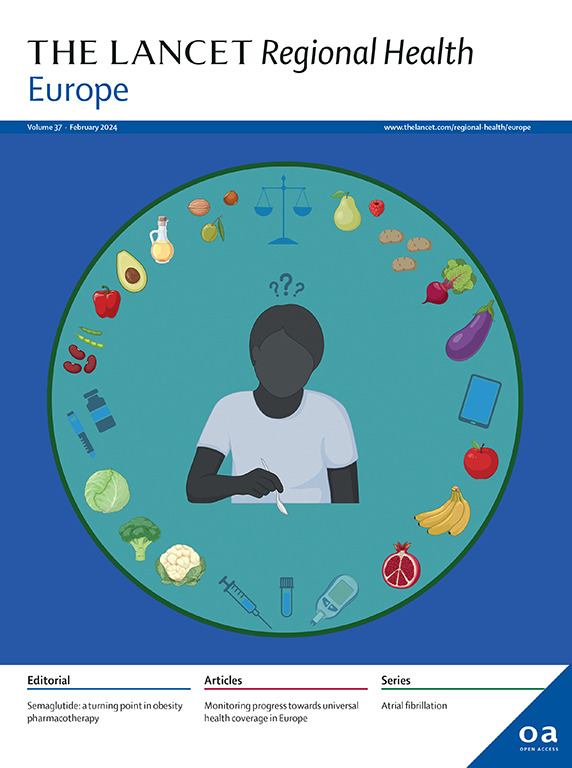Incidence rate of infective endocarditis by socioeconomic position: a Danish nationwide cohort study (2000–2022)
IF 13.6
Q1 HEALTH CARE SCIENCES & SERVICES
引用次数: 0
Abstract
Background
People with lower socioeconomic positions have a higher risk of cardiac and infectious diseases than those with higher socioeconomic positions. However, how the increasing incidence of infective endocarditis among different socioeconomic groups has played out remains unclear. We therefore aimed to investigate nationwide temporal trends in infective endocarditis incidence rate by socioeconomic position in Denmark.
Methods
Using nationwide Danish registries, we investigated infective endocarditis incidence rate (2000–2022). As socioeconomic position indicator, we used affluence level (accounting for household-level income and wealth), dividing the population into low, medium, and high affluence. Average annual percentage changes were computed to evaluate temporal trends. Slope index and relative index of inequality were calculated to obtain inequality gradients.
Findings
Per 100,000 person-years, the incidence rate increased from 8.7 in 2000 to 21.2 in 2022 among low; from 7.4 to 14.3 among medium; and from 6.2 to 13.1 among high affluence people. The average annual percentage change was 4.3% among low, 3.5% among medium, and 3.7% among high affluence people. The slope index of inequality increased from 3.8 additional cases per 100,000 person years (95% CI: 0.4–7.3) in 2000 to 12.3 (95% CI: 7.4–17.1) in 2022. The relative index of inequality increased from 1.68 (95% CI: 0.90–2.44) to 2.13 (95% CI: 1.49–2.78).
Interpretation
The infective endocarditis incidence rates increased in all affluence levels, with highest rates consistently found in the lowest affluence group, indicating that people with lower socioeconomic positions faced a disproportionately higher risk of infective endocarditis. These findings highlight the need to consider socioeconomic factors when addressing modifiable determinants that may curb the rise in infective endocarditis incidence.
Funding
Independent Research Fund Denmark (grant no. 3101-00102B) and Center for Population Medicine, Department of Clinical Epidemiology, Aarhus University.
社会经济地位对感染性心内膜炎发病率的影响:丹麦全国队列研究(2000-2022)
背景与社会经济地位较高的人相比,社会经济地位较低的人患心脏病和传染病的风险更高。然而,不同社会经济地位群体的感染性心内膜炎发病率的增长情况尚不清楚。因此,我们旨在调查丹麦全国范围内按社会经济地位划分的感染性心内膜炎发病率的时间趋势。方法通过丹麦全国范围内的登记,我们调查了感染性心内膜炎发病率(2000-2022 年)。作为社会经济地位指标,我们使用富裕程度(考虑家庭收入和财富),将人口分为低、中、高富裕程度。计算年均百分比变化以评估时间趋势。调查结果每 10 万人年中,低富裕人群的发病率从 2000 年的 8.7 上升到 2022 年的 21.2;中富裕人群的发病率从 7.4 上升到 14.3;高富裕人群的发病率从 6.2 上升到 13.1。低度富裕人群的年均百分比变化为 4.3%,中度富裕人群的年均百分比变化为 3.5%,高度富裕人群的年均百分比变化为 3.7%。不平等斜率指数从 2000 年的每 10 万人年增加 3.8 例(95% CI:0.4-7.3)上升到 2022 年的 12.3 例(95% CI:7.4-17.1)。解释感染性心内膜炎的发病率在所有富裕程度的人群中都有所上升,而在最低富裕程度的人群中发病率一直最高,这表明社会经济地位较低的人群患感染性心内膜炎的风险更高。这些发现突出表明,在研究可改变的决定因素时,有必要考虑社会经济因素,以遏制感染性心内膜炎发病率的上升。基金资助丹麦独立研究基金(资助编号:3101-00102B)和奥胡斯大学临床流行病学系人口医学中心。
本文章由计算机程序翻译,如有差异,请以英文原文为准。
求助全文
约1分钟内获得全文
求助全文
来源期刊

Lancet Regional Health-Europe
Multiple-
CiteScore
19.90
自引率
1.40%
发文量
260
审稿时长
9 weeks
期刊介绍:
The Lancet Regional Health – Europe, a gold open access journal, is part of The Lancet's global effort to promote healthcare quality and accessibility worldwide. It focuses on advancing clinical practice and health policy in the European region to enhance health outcomes. The journal publishes high-quality original research advocating changes in clinical practice and health policy. It also includes reviews, commentaries, and opinion pieces on regional health topics, such as infection and disease prevention, healthy aging, and reducing health disparities.
 求助内容:
求助内容: 应助结果提醒方式:
应助结果提醒方式:


